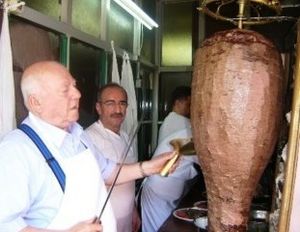Rotisserie facts for kids
Rotisserie, also known as spit-roasting, is a way to cook meat. It uses a long rod called a spit to hold food. The food cooks over a fire, like in a fireplace or campfire, or in an oven. This method is great for cooking big pieces of meat or whole animals. Think of a whole pig or turkey. As the meat turns, it cooks evenly in its own juices. This also makes it easy to baste the meat often. Basting means pouring juices or sauce over the meat to keep it moist.

Contents
History of Rotisserie Cooking
In olden times, like the Middle Ages, the spit was a popular way to cook meat. In big homes, a servant, often a boy, would sit and slowly turn the metal rod. This person was called a "spit boy" or "spit jack."
Later, machines were invented to turn the spit. Some were powered by dogs walking on treadmills. Others used steam power or clockwork gears. Today, most spits are turned by electric motors.
The word "rotisserie" comes from French. It first appeared in Paris shops around 1450. It can also mean a machine that cooks food this way. Sometimes, it refers to a restaurant that specializes in spit-roasted meat. In professional kitchens, the "rotisseur" is the chef who cooks roasted and grilled foods.
Horizontal Rotisserie Cooking
This type of rotisserie holds the spit straight across, or horizontally. It's often used to cook whole chickens or large roasts. These can be beef or pork. The spit might be over an open grill or inside a regular oven. Big industrial ovens use many spits to cook lots of meat at once. These are often used to make roasted meats for stores.
When using a horizontal rotisserie, it's important for the food to be balanced. If the food is not balanced, it can make the motor work too hard. It might even stop the turning. Loose chicken legs or wings can also cause problems. So, some skill is needed to skewer the food correctly.
Many modern ovens for homes come with a rotisserie. The motor is usually hidden inside the oven. You remove the regular oven racks to use it. Special parts might be needed to hold the spit in place.
The speed of turning can change. It depends on the food and how close it is to the heat. Large animals, like whole pigs, might turn slowly. This could be 1 to 3 times per minute. Some inventors suggest 6 turns per minute is good for many foods.
When cooking a whole animal, it's often best to turn it faster at first. This helps the inside cook without burning the outside. Once the outside starts to get crispy, you can slow down the turning. This helps keep the juices on the meat, making it taste better. It's also good to start cooking the meat further from the heat. Then, you can move it closer later on.
Supermarkets often use horizontal rotisseries for their rotisserie chickens. Metal bars hold the chickens firmly in place while they cook.
Vertical Rotisserie Cooking

Another type of rotisserie is the vertical rotisserie. Here, the heat comes from the side. Sometimes, heat comes up from below. With this style, balancing the food is less important. This is helpful because the meat is usually shaved off a little at a time.
Some popular dishes cooked on a vertical rotisserie include:
- Döner kebab from Turkey
- Gyro from Greece
- Shawarma from the Middle East
- Taco al pastor from Mexico
See also
 In Spanish: Rosticería para niños
In Spanish: Rosticería para niños


